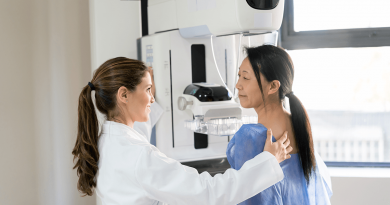All about prosthesis
Losing a limb can be a traumatic experience. The approach by the rehabilitation team – including a physical medicine and rehabilitation doctor, physical therapist and prosthetist – can alleviate the stress that patients experience.
In my experience in the postoperative clinic, patients with amputation and their families are eager to know how to get a prosthesis and how to be prepared for it.

When to get a prosthesis
Timing of prosthetic fitting and training varies widely, depending on multiple factors including the age of patient and the type of amputation (traumatic vs. infections vs. vascular conditions). It is usually six to eight weeks or longer once the residual limb has healed.
Prosthetic training may begin while the patient is in an inpatient rehabilitation setting or during outpatient follow-up. The first prosthesis fitting should be implemented as soon as possible after wound healing.
In the meantime, gait training starts without a prosthesis. The choice of prosthetic devices should be individualized based on the capacity and goals of the patient, with the intent to allow the highest possible level of function. A team approach to prosthetic prescription writing should be used whenever possible, including the full rehabilitation team working closely together to optimize outcomes.
Exercise and mobility after amputation
Contractures (shortening of muscles) may develop due to improper positioning in bed or prolonged sitting in a wheelchair. Contractures of the hip flexors, abductors and external rotators are common in the transfemoral (above the knee) amputee. The transtibial amputee (below the knee) is at risk for developing hip and knee flexion contractures. This is why physical and occupational therapists are indispensable in creating an exercise regimen and educating the patient on how to follow it after discharge.
It is important to avoid laying on your side to provide a prolonged low-load stretch on the hip flexors and prevent hip flexion contracture. This, in turn, helps the readiness of the residual limb for prosthesis.
Most importantly, stretching and strengthening the residual limb is essential to make it strong and flexible to use a prosthesis. In addition, it is very important to follow safety awareness and fall prevention strategies, including asking for appropriate assistance during mobility and use of assistive devices, as fall is common after amputation, which may delay healing and time for prosthesis.
Shrinker vs. regular socks?
A shrinker is a medical compression device that applies pressure to the residual limb to reduce swelling, reduce the size of the limb and promote shaping of the limb for prosthesis. Swelling is common after amputation as the musculature (muscles help to pump the fluid in the arms and legs back into circulation) of the limb has changed, making it harder for the fluid to get back into circulation. As a result, it shapes residual limb to become more rounded and symmetrical for better fit in the socket for the prosthesis. It is made of an elastic-style material that, when stretched over residual limb, provides the right amount of pressure to reduce swelling. It is usually recommended to wear it once the incision is healed and sutures removed (typically 21-28 days after surgery). The size of the shrinker is customized for the patient, which is usually coordinated between the PMR doctor and the physical therapist. Shrinkers should be worn all the time for three to four weeks to get the maximum benefit.
One size fits all
When a limb is amputated, the residual limb is different from one person to the next. The most fundamental element in creating a prosthetic is the socket, the crucial interface that connects these sophisticated prosthetics to a patient’s residual limbs. The prosthetic limb may be fitted with the most technological advancements, but the socket remains the real point of contact. Different measuring techniques are currently used in industry to capture residual limb size and shape. Prosthetics are customized based on residual limb size and socket.
Cost and coverage
The cost of prosthetics varies depending on circumstances:
- The level of amputation.
- The patient’s level of activity.
- The reason for the amputation.
- The technology used to make the device.
Insurance coverage varies but some plans do cover or partially cover prosthetics. Several organizations, many of them non-profits, assist Americans in need. Some provide financial assistance, while others offer free artificial limbs or devices. For more information, visit amputee-coalition.org. CARE and HAGNER are the organizations for prosthesis in Houston.
Other community resources:
- Catholic Charities: (713) 526-4611
- Memorial Assistance Ministries: (713) 468-4516
- Texas 211 helpline: (877) 541-7905
- Amputee Coalition: (888) 267-5669
- New Life Brace and Limbs: (713) 440-7000
- Steps of Faith Foundation: (615) 426-6034
- SWCM can provide an application to the New Life Braces and Limbs Foundation.
Learn more about Baylor Medicine Surgery services and BCM-Ottobock Care.
By Umamaheswari Lakshmanan, instructor and nurse practitioner in the Department of Surgery



